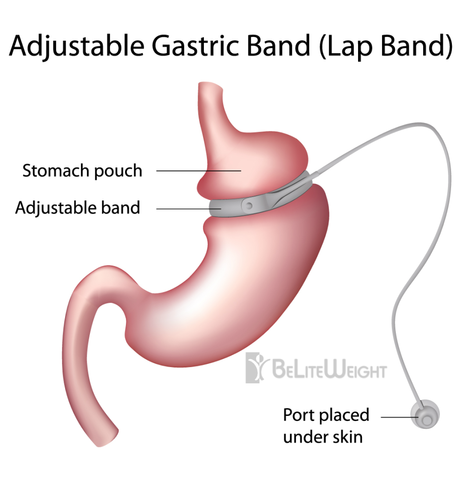
The beginning experiments of weight loss surgery in the United States began in the 1960s with the malabsorptive operation known as the Jejunoileal bypass, but it wasn't until 1994 when Dr.'s Wittgrove and Clark began their work with laparoscopic technology that cosmetically viable options became available and the procedures grew in popularity. More than 13 years ago now, in 2004 BeLiteWeight began servicing their first patients as weight loss surgery began growing in popularity. Since then the BeLiteWeight team has facilitated more than 15 thousand successfully Banded, Sleeved, or Bypassed patients. The first few years of BeLiteWeight's history medical professionals recommended an operation known as the Lap Band that has since been discovered to have a relatively large amount of complications when compared to the more modern Gastric Sleeve or even the Gastric Bypass.

The surgical weight loss option known as the lap band is considered a restrictive procedure because it places a foreign object in stomach around the food pouch and limits the amount of food that can "slide" through the stomach at one time. Unfortunately, with BeLiteWeight's long history of accomodating patients for weight loss surgery, our team can verify the high rate of long term complications with this surgery. Beginning as early as 3 years the plastic "band" in the stomach nearly always gets dislodged and rejected by the body causing the surgery to be reversed. Fortunately, the other surgical options available to those looking to lose weight have proven with time to be much more reliable without any of these long-term complications. Both the Vertical Sleeve and the Gastric Bypass illustrated below have been advocated for by medical professionals for nearly 10 years with a substantial amounts of success. The long term effects of the Mini Bypass or the Reux-En-Y Gastric Bypass are better for combating diabetes than the Gastric Sleeve. Studies have shown the beneficial diabetic effect of the Gastric Sleeve comes with weight loss while the effects on diabetes for the Gastric Bypass are quick and sometimes even instantaneous.


Fore more information about the Gastric Sleeve and other surgical weight loss options call BeLiteWeight today!
This entry was posted in Bariatric Surgery, Gastric Bypass, Gastric Sleeve Surgery, General, Health, Lap Band Surgery, Obesity, Weight Loss, Weight Loss Success Stories, Weight Loss Surgery and tagged Gastric Bypass Surgery, gastric sleeve, Gastric Sleeve Plication, Gastric Sleeve Surgery, Gastric Sleeve Testimonials, Lap Band Surgery, Laparoscopic Vertical Sleeve Gastrectomy, Vertical Sleeve Gastrectomy, Weight Loss Surgery by Jamie Eberle. Bookmark the permalink.
About Jamie Eberle
Jamie Eberle is the Chief Financial Officer of BeLiteWeight. BeLiteWeight has helped over 7,000 patients have safe, affordable and successful weight loss surgery over the past eight years. Jamie has had bariatric surgery and knows the ins and outs of the different procedures, including: gastric sleeve surgery, gastric sleeve plication, vertical sleeve gastrectomy and gastric bypass surgery, and other bariatric surgery procedures. BeLiteWeight focuses on each patient's needs to help them choose the right procedure and get started on the path to a healthier life.

